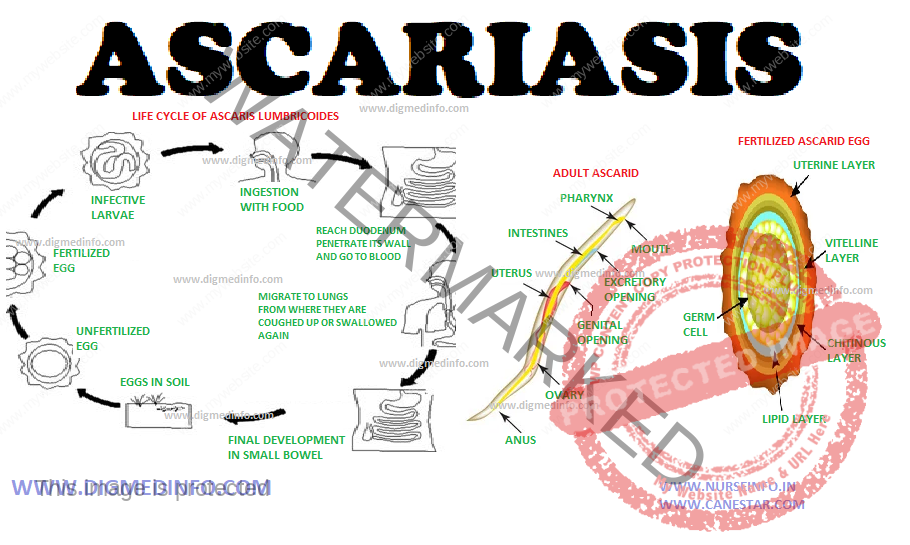ASCARIASIS – General Characteristics, Life Cycle, Pathogenesis, Clinical Features, Diagnosis, Treatment and Prevention
General Characteristics
Ascariasis is worldwide in distribution and is caused by the nematode Ascaris lumbricoides. The worm measures 20-35 cm in length. The female is larger than the male. The females lay several thousand eggs every day. The eggs are elliptical, 30-40 μ x 50-60 μ in size with an outer dense mammilated shell and a smooth translucent inner shell. They are passed in feces. They become embryonated and infective in the soil in 2- 3 weeks and they can remain viable under optimum conditions for years.
Life Cycle
Embryonated eggs are ingested with food or water and the larvae hatch out in the small intestine. They penetrate the intestinal mucosa to enter the venules or lymphatics and travel to the lungs, where they develop for about 10 days. They then enter the alveoli to be coughed up and swallowed. During the pulmonary phase the larvae undergo four moultings and become resistant to gastric acid. The larvae grow and mature in 2-3 months. Life span of this worm is 6-15 months.
Pathogenesis
During the stage of larval migration, pulmonary symptoms like cough, wheezing and hemoptysis may occur (Loeffler’s syndrome) and used to be a common cause of respiratory symptoms in children. The adult worms ingest nutrients from the small intestine and lead to nutritional deprivation. Large number of adults may form tangled masses and obstruct the small intestines. The worm may migrate to ectopic sites like the stomach, nasal cavity, biliary tree, pancreatic ducts, respiratory passages, female genital tract or others. Absorption of the products of living and dead worms leads to the development of allergy and toxic symptoms.
Clinical Features
Those due to larvae: Respiratory symptoms such as cough, hemoptysis or wheezing may develop 1-5 days after swallowing the eggs. Eosinophilia may be present. Clinical severity depends upon the worm load and reactivity of the host. The liver may be enlarged and histology may show centrilobular necrosis. Rarely larvae may reach the brain, giving rise to convulsions. Other organs may also be affected.
Those due to adult worms: Light infestations are asymptomatic. Moderate worm loads produce abdominal pain, pica, diarrhea, abdominal distention and grinding of the teeth (bruxism). Infected children have voracious appetite but they remain malnourished despite adequate intake of food. Migration of worms to biliary ducts or pancreatic ducts leads to obstruction. In heavy infection the masses of worms may lead to intestinal obstruction and they may be palpable.
Diagnosis
It is made from the history of passing round worms in the stool or the children may vomit round worms. Diagnosis is confirmed by demonstrating the characteristic ova in feces. In the rare event of infection by male worms alone, ova may not be present in feces. During the stage of larval migration, the diagnosis has to be presumptive
Treatment
The adult worms respond to a variety of anthelmintics. Effective, safe and polyvalent anthelmintics are preferred at present. In more than 30% of patients multiple helminths occur, common combination being roundworm, whipworm and hookworm and broad spectrum anthelmintics are more advantageous in them.
Benzimidazole drugs which include albendazole and mebendazole bind to nematode β tubulin and inhibit parasite microtubule polymerisation which causes death of adult worms which may take a few days to complete.
Prevention
Improvement in nutritional status of children, health education, especially pertaining to personal hygiene and environmental sanitation reduce the infection rates. Mass deworming campaigns are helpful in endemic areas to reduce worm loads temporarily but reinfection withinmonths is the rule.


